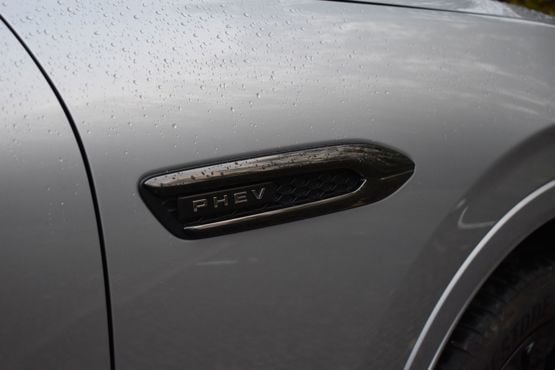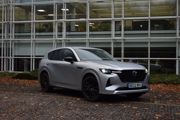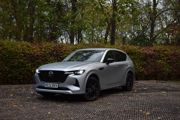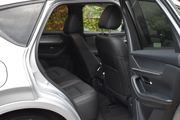Review
Our long term CX-60 has now been returned to Mazda, but just weeks before I drove the car on a family holiday to France. It gave me chance to think about its long-distance capabilities.
Inside, the boot was more than capable of accommodating luggage for four with room to spare and all passengers had plenty of space for holiday paraphernalia. The three-pin plug socket for rear passengers was used regularly for charging devices as was the wireless charging pad up front. There are no conventional USB sockets, only smaller USB-C so an additional cable was needed here.

The air-conditioned front seats were a godsend and although relatively flat and lacking in side support, they were comfy enough for the long journey.
The relatively small fuel tank (50l) with indicated 290 miles range when full meant regular fuel stops were needed at France's pricey fuel stations (around 10% more than the UK) however I was able to make use of the three-pin charging lead to top up with (free) electricity from our holiday chalet. Unfortunately on several occasions the car was indicating ‘charge complete’ when it hadn’t taken on any electricity at all. I assume this was more down to the electricity supply rather than a fault with the car. Unplugging and trying again usually fixed the issue and saw the electric range filled in six hours.
We didnt manage to crack the official WLTP mpg figure of 188mpg, as with most PHEVs this is a little far fetched for anyone that regularly uses the petrol engine. On longer trips the CX-60 will easily manage more than 40mpg, however. When utilitising the charged battery, the figure sits closer to 50mpg. Drivers that rarely travel more than 30 miles between charging opportunites should achieve much better figures than we did.
The CX-60 has many positive attributes and was a firm favourite with those who drove it. The only gripes were the overly firm suspension and the occasional over-sensitivity of the safety alert systems.

Time for a service
The service warning light illuminated on the CX-60's dashboard indicating that its 12.500-mile service was due.
Delving into the on-board computer revealed 600 miles remaining so it was booked into our nearest dealer, Donald’s Mazda in Peterborough.
During that 600-mile countdown the computer seemed to constantly reset itself, and over a period of a couple of weeks never actually reached 0 miles but instead returned to 600 miles no matter how many journeys the car took. Nonetheless, we had the work carried out.
While at the dealership there were also three outstanding recall notices on the car that required attention. The first for ‘improper indication of the fuel gauge’, which involved removing the fuel pump and re-routing the fuel transfer tube, the second was ‘re tightening of the Front stabiliser Control link nuts’ and the third for an ‘instrument cluster blackout concern’ which meant re programming the instrument cluster. We'd previously sent the car in to have the suspension looked at as it was 'groaning' over bumps.
The service cost totalled £268.42 and included, oil, filter, screen wash and fuel system cleaner. It also included a health check which showed both front tyres were wearing on the outer edge although no intervention was needed. And a wash, which was nice.
Large dimensions don't hamper performance
The CX-60 is a good-looking car, while the aggressive front is unmistakably Mazda, the car on the whole has a slight Alfa Romeo look about it, especially if chosen in the Soul Red (+£900) paintwork rather than our car's Sonic Silver shade.
It feels like a big car, partly due to the flat nose and high level, expansive bonnet. At 4,745 mm long, 1,890 mm wide and 1,680 mm tall it’s bigger than popular models in the SUV segment, like the Audi Q5 and a Mercedes GLC, and has a largest boot too.
On the inside, front seat passengers get a feeling of space with a wide centre console and plenty of legroom, however legroom behind a 6ft driver is a little cramped feeling more economy class than business.

At 2,667Kg it feels weighty out on the road, however, it doesn’t disappoint in the performance department with aggressive acceleration. The CX-60 PHEV is powered by a 2.5-litre petrol engine, paired with an electric motor, giving a combined 327PS output and a sound not dissimilar to a supercharger on full throttle. 62mph arrives in 5.8 seconds, that’s virtually the same as a Ford Focus ST (5.7 secs). Sport mode has come to be known as 'beast mode' in my house.
The CX60 PHEV gets a slightly smaller fuel tank than its diesel sibling – 50 litres vs 58 litres but has the added advantage of the claimed 39 miles EV range. I have seen as much as 45 miles after a charge on the dashboard display but in reality, I seem to get around 30 miles. It does have the ability to self-charge though, using braking and coasting to re-generate some electricity. On local stop start journeys I have seen some success with this system however on a recent 200 mile, mainly motorway and A road journey I saw just 1 mile of electricity return to the battery.
Handling impresses
Long gone are the days when big SUVs were lumbering beasts, as their heavy weight and compromised chassis resulted in severe rolling around even the mildest of corners.
As drivers turned away from the traditional small and large family car sectors in favour of mid and large ‘sports utility vehicles’, carmakers pushed more of their R&D budgets into producing big vehicles with excellent driving capabilities.
BMW led the way – with others chomping at its tailpipe. Mazda is one of those playing catch up, with the CX-3 and CX-5 showing a clear indication of its potential. However, the CX-60 is the carmaker’s first SUV to live up to its ‘celebrate driving’ vision.
Big dimensions – height/width/length – are beautifully masked on rural routes with confident and accurate handling, aligned to a poised rise, which results in tight cornering and minimal body roll. Back in an urban environment, it remains a breeze to drive in the midst of heavy traffic and tight roads.
Equally, high speed motorway driving is effortless. But the CX-60’s Achilles’ heel is on undulating roads where the chassis becomes unwieldy and wallowy. Without care, the pitching can become quite unnerving, forcing you to back off the accelerator to allow the suspension to settle.
So, the CX-60 is far from perfect, but it is one of the better big SUVs from a driver perspective.
I should add that I’ve noticed a slightly improvement after the car returned to Mazda for a bit of TLC. The front shocks had started groaning while braking downhill, even on gentle inclines. Mazda lubricated and adjusted the front suspension bush which has tightened everything up, but not enough driving has taken place since to give a more comprehensive update.
It also inspected the screen wash reservoir after I suspected a leak – a full five-litre carton was consumed in little over a week. No leak was found, although Mazda did point out that with the screen wash coming out of the windscreen wipers, as opposed to the bonnet, with an additional spray for the headlights, it boosted the cleaning power, but also used a lot of fluid.
Assistance systems are too sensitive
We’ve been testing the CX-60 for around a month now and we’ve come to a clear conclusion: it has a nervous disposition; I’d go so far as to say it is petrified of other cars on the road.
The big Mazda is packed with safety technology, including brake support with warning, turn-across traffic warning and driver attention alert. So far, so good.
However, the system is ultra-sensitive. Pass a line of parked cars and, inevitably, the brake alert flashes on the head-up display; enter a roundabout after a car has just crossed and the traffic alert starts chiming; look over your shoulder to check the outside lane before overtaking on a dual carriageway and the driver attention warning pings.
It’s not just our test car; other drivers we’ve spoken to have reported the same situations with their own vehicles.
I was advised to delve into the infotainment options within Mazda Connect to adjust the sensitivity levels.

Accessed via a rotary controller, which is surrounded by quick-step keys for entertainment, home, navigation and return (as well as old-school buttons and knobs for volume and climate control), the system is one of the easiest to use on the market, enabling simple scrolling through logical menu options. And what an incredible range of options: changes can be made to cruise control, smart brake support, lane-departure warning and a host more.
Generally, sensitivity can be adjusted across three levels: early, normal and late. You can also opt for vibration or sound alerts.
I adjusted the ‘front smart brake support with turn across traffic’ sensitivity in the hope that the car would worry less about cars that have actually passed when I enter a roundabout and – while not completely fixing the niggle – it certainly reduced the frequency of the alert. It also lessened the CX-60’s susceptibility to braking when perceiving a line of parked cars as an imminent crash threat. It’s not perfect, but it has definitely improved the driving experience.
It wasn’t the only change I made while in the infotainment system. Having had the boot twice slam into my shoulder while loading groceries (I’d inadvertently wagged my foot under the gesture controlled bumper sensor and the boot seems not to recognise obstructions), that was the first thing to be switched off.
In the era of connected cars, we’ve had some over-the-air software updates that were non-intrusive, while the app contains a veritable wealth of useful information, including vehicle finder, remote locking, journey planning, range status, remote adjustment of climate control, vehicle charging and EV charging station search.
The over-sensitive safety systems distract from what is otherwise an excellent car – one that thoroughly justifies its premium positioning. The CX-60 has the best interior of any Mazda yet, with soft-touch furnishings and an attractive, well-designed layout which offers a real sense of wellbeing on long journeys.
Generous interior dimensions (length/width/height of 4,745/1,890/1,680mm) results in ample room for front and rear passengers, with the widest armrest between driver and passenger of any car I’ve driven – a full 27cm! Boot capacity of 570 litres (rising to 1,726 litres with rear seats down) is among the best in class.
Meanwhile, the seats, with electric tilt, slide, recline, height and lumbar adjustment, take the technology and materials learnings first seen in 2019’s Mazda 3, with their S-shape design and enhanced pelvis support, and add new levels of comfort.
It’s a terrific environment for distance or urban driving – provided you can overlook the various phantom flashes and alerts.
Mazda CX-60 PHEV Homura joins our fleet
Mazda has persistently ploughed its own furrow when it comes to technology, extolling the virtues of rotary engines and, more recently, the SkyActiv compression ignition petrol, which it labelled as an ICE solution that combined petrol performance with diesel efficiency.
But with the UK’s 2030 ban on the sale of new petrol and diesel vehicles looming, and other countries introducing with their own deadlines, the Japanese company has been forced to reassess its priorities.
In March 2021, Mazda delivered its first full electric car, the MX-30, in the UK which we had on long-term test last year; 18 months later, it’s the turn of its first plug-in hybrid model, the CX-60.
The full-size SUV has an official electric-only range of 39.15 miles and emissions of 33g/km. Following clarification of HMRC company car tax rules, which state the range figure can be rounded up, the car sits in the 8% benefit-in-kind bracket.
Like many PHEVs, it has a smallish fuel tank (50 litres), giving a range of around 250 miles, according to the on-board computer. It seems pretty accurate, with an initial fuel consumption figure of just above 42mpg, admittedly with more petrol-only driving than I’d like, which means I’ve spent more time in the fuelling station than I’d like.
Our test car is the mid-range Homura trim, priced £48,170. The 17.8kW battery has a 7.2kW onboard charger, enabling a full charge in a little over two-and-a-half hours.

The standard equipment list is generous and includes auto levelling and high beam control LED headlights, reversing camera, front/rear parking sensors, 12.3-inch display, head-up display, front seat heaters/ventilation, heated outer rear seats, blind spot monitoring with rear cross traffic alert, driver attention alert, lane keep assist with lane departure warning and front smart brake support with turn-across traffic alert.
We also have several optional extras, including convenience pack (wireless charging, 360-degree view with see-through view - £1,000) and driver assistance pack (adaptive LED headlights, radar cruise control - £1,100), taking the price to a weighty £50,920 – although still considerably less than premium PHEV rivals such as the BMW X3, Audi Q5 and Volvo XC60. That means monthly BIK bills of £102/£204 for 20%/40% taxpayers.
Initial impressions are good; Mazda is taking big strides forward in terms of quality and comfort, and the car is surprisingly agile for a near 2.7-tonne brute. But more on that in future tests.
















 Petrol Hybrid
Petrol Hybrid

















